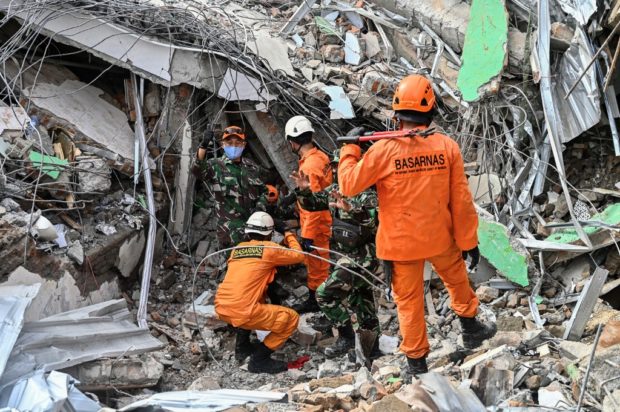
Rescuers try to remove the body of an earthquake victim trapped in a collapsed building in Mamuju on January 16, 2021, a day after a 6.2-magnitude earthquake rocked Indonesia’s Sulawesi island. Photo by Hariandi Hafid / AFP
MAMUJU, Indonesia — The death toll from a powerful earthquake on Indonesia’s Sulawesi island has jumped to 56, authorities said Sunday, with thousands left homeless as rescuers raced to find anyone still alive under mountains of rubble.
Hospitals were overrun with hundreds of injured after the 6.2-magnitude quake struck in the early hours of Friday, triggering panic among residents of the island, which was hit by a 2018 quake-tsunami disaster that killed thousands.
Rescuers have spent days hauling corpses from beneath crumpled buildings in Mamuju, a city of 110,000 people in West Sulawesi province, where a hospital was flattened and a shopping mall lay in ruins.
Others were killed south of the city.
The official death toll stood at 56 — up from 46 on Saturday — but the count could still climb.
Aerial images from the devastated seaside city showed buildings reduced to a tangled mass of twisted metal and chunks of concrete, including the regional governor’s office.
It was unclear how many more bodies could be under the debris, or if there was anyone still trapped but alive more than two days after the disaster.
Authorities have not given a figure for how many survivors have been rescued.
A pair of young sisters plucked from under the mass of concrete and other debris were treated in hospital.
Meanwhile, corpses were recovered from under a collapsed hospital, while five members of a family of eight were found dead in the crumpled remains of their home.
Running low on food, supplies
The thousands left homeless by the quake took to makeshift shelters — many little more than tarpaulin-covered tents filled with whole families — that were lashed by heavy monsoon downpours.
They said they were running low on food, blankets and other aid, as emergency supplies were rushed to the hard-hit region.
Many survivors are unable to return to their destroyed homes, or were too scared to go back fearing a tsunami sparked by aftershocks, which are common after strong earthquakes.
“It’s better to take shelter before something worse happens,” said Mamuju resident Abdul Wahab, who took refuge in a tent with his wife and four kids, including a baby.
“We hope the government can deliver aid soon like food, medicine and milk for the children,” he added.
Worried about an outbreak of Covid-19 in the crowded camps, authorities said they are trying to separate high- and lower-risk groups.
The quake’s epicenter was 36 kilometers (22 miles) south of Mamuju and it had a relatively shallow depth of 18 kilometers.
Disaster-prone
In neighboring Kalimantan, Indonesia’s section of Borneo island, at least five people had died in heavy flooding while dozens more were missing, according to reports, while floods have killed at least five people in Manado, hundreds of kilometres north of the quake disaster in Sulawesi.
Landslides in West Java killed at least 28 this week as the rainy season heaps misery on parts of the sprawling nation.
At the eastern end of Java island, rumbling Mount Semeru erupted late Saturday, shooting a plume of ash and debris some 4.5 kilometers (2.8 miles) into the sky, as bright red lava flowed down its crater. There were no immediate reports of casualties.
Disaster-prone Indonesia, a Southeast Asian archipelago of nearly 270 million, experiences frequent seismic and volcanic activity due to its position on the Pacific “Ring of Fire”, where tectonic plates collide.
In 2018, a 7.5-magnitude quake and a subsequent tsunami in Palu on Sulawesi left more than 4,300 people dead or missing.
And on December 26, 2004, a 9.1-magnitude earthquake struck off the coast of Sumatra and triggered a tsunami that killed 220,000 throughout the region, including around 170,000 in Indonesia.